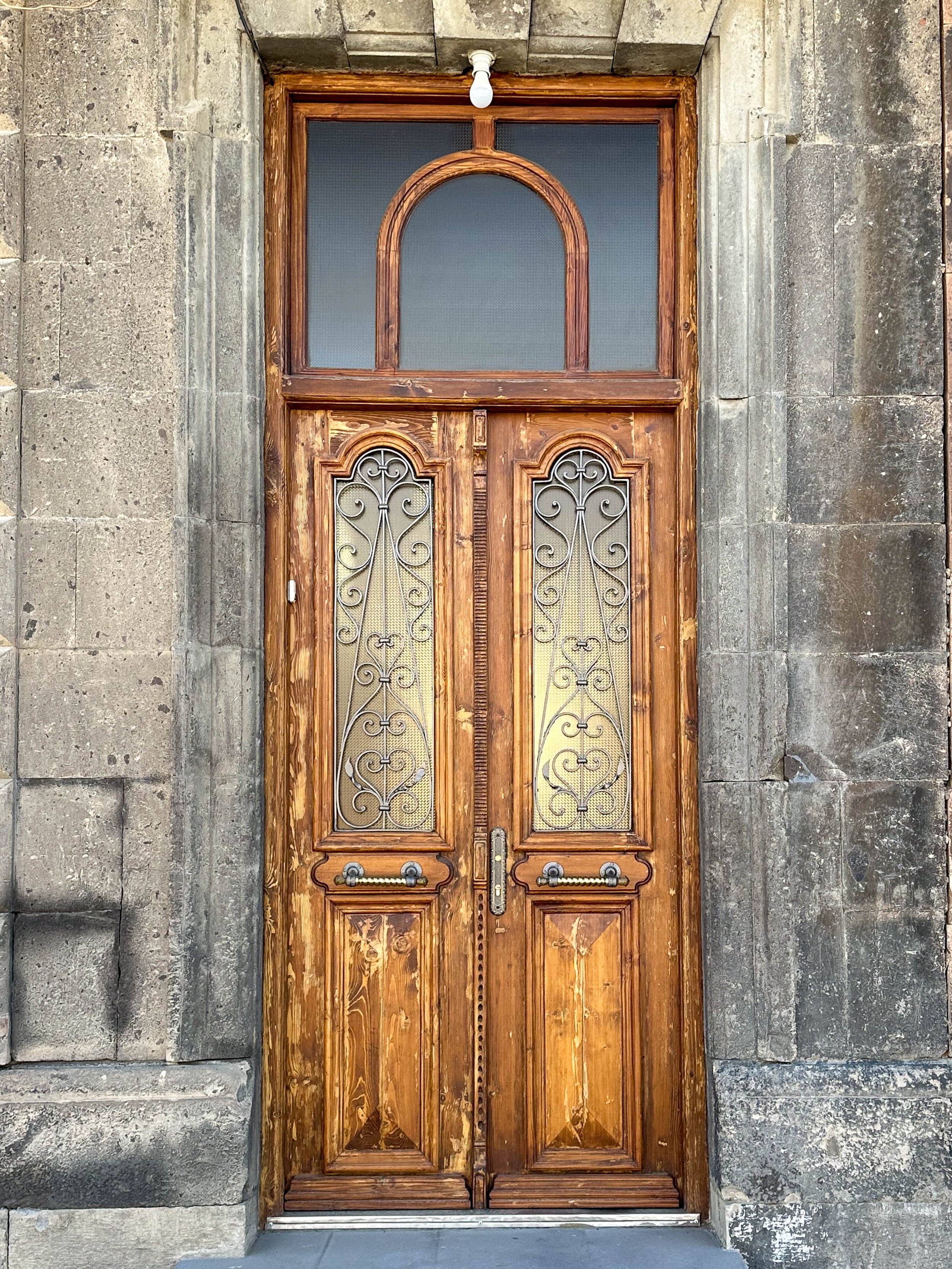The offerings for breakfast were meagre but nonetheless we enjoyed a cup of tea and a hard-boiled egg plus some bread.
We still had an hour before boarding our bus, so we strolled around the block in which our hotel was located. Some interesting doors were photographed during this brief walk beyond Abovyan Street.
Building near Villa Kars, Gyumri
Door near Villa Kars, Gyumri
Door near Villa Kars, Gyumri
After checking out of the hotel, Anna then led us on further exploration of Gyumri. Many of the more interesting buildings are constructed from the black and red tufa stone. This rock is mined from quarries where both the black and apricot coloured stone occur in close proximity. They are presumably of similar mineral composition with the variation being in the red having a higher iron oxide content.
Building built from black & orange tufa stone, Gyumri
Our meandering down Shahumain Street brought us eventually to Vardanants Square and the recently reconstructed and yet impressive Yot Verk Church, (Seven Wounds of the Holy Mother of God Church!)
This Armenian Apostolic Church does not have any icons but religious paintings are plentiful and often grotesque. The church was busy with visitors and worshipers, and several of the devout seemed to have an insatiable desire to go around kissing the images, walls and altars. An interesting feature of this cathedral was the use of baby-blue drapes around the main altar.
Inside Yot Verk Church, (Seven Wounds of the Holy Mother of God Church!), Gyumri
We ventured into an apse area, and much to our surprise, a priest in a small adjacent room beckoned us to enter. We initially thought it might be a confessional room but that proposition proved to be unfounded.
The priest sat us down and with a cheerful smile and welcoming demeanour, commenced a protracted blessing session. This intriguing ceremony lasted for about five minutes, during which time the priest recited continual prayers and waved a largish silver cross back and forth over our foreheads.
The blessing terminated with the silver crucifix being pressed upon our lips followed by the priest making all sorts of ‘crossing gestures’ and the like. We then thanked this most amiable and obviously senior cleric for his concern for our souls and his attempt to set us on the path to righteousness. Incidentally, his efforts were to no avail, we’re sad to confess!
Priest giving blessing to Jak, Yot Verk Church, (Seven Wounds of the Holy Mother of God Church!), Gyumri
Priest, Yot Verk Church, (Seven Wounds of the Holy Mother of God Church!), Gyumri
After a coffee in the fashionable Rizhkov Street we returned to the central square and boarded the bus for our trip to Dilijan.
Jak & Corinne having coffee in shopping mall, Gyumri
The road followed the M7 highway and the first major town we passed through was Spitak. This was the epicentre of the disastrous 1988 earthquake.
Gas powered bus at Spitak between Gyumri and Dilijan
At Fioletokovo, we turned off the highway and drove a short distance along a very bumpy and dusty road to visit the family home of Molokan people, namely Mikhail and Natalya Rudometkin.
Fioletovo Village
The Molokans are an ethnic minority group living in an enclave as a spiritual Christian sect that evolved from Eastern Orthodoxy in the East Slavic lands. They are somewhat like a cross between Quakers and Amish people in their adherence to a strict lifestyle and self-sufficiency. Their subsistence is largely based upon dairy and vegetable produce.
We had a most interesting lunch at their home with tea from a samovar, potato and cabbage piroshkis plus jam filled crepes. Our Armenian hostess Natalaya, who only speaks Russian, was charming and obviously so pleased that we had thoroughly enjoyed the meal she had prepared.
Natalya Rudometkin serving tea at house of Molokans ethnic minority people, Fioletovo Village
Group at tea ceremony at house of Molokans ethnic minority people, Fioletovo Village
Home-made pastries, pancakes & jam at house of Molokans ethnic minority people, Fioletovo Village
We spent a short time wandering around their garden and orchard which are positioned along the banks of a fast flowing stream with adjacent areas of rich alluvial soil in which they grow their vegetables.
Garden at house of Molokans ethnic minority people, Fioletovo Village
Garden at house of Molokans ethnic minority people, Fioletovo Village
House of our hosts, Mikhail and Natalya Rudometkin, Molokans ethnic minority people, Fioletovo Village
Along the dusty road nearby, we photographed ancient tractors and then came upon a group of very young children playing in a sand pit area. As part of their religious sect, even the female children wear head scarves, as do their mothers.
Jak, Sinclair & Chris with tractor & trailer, Fioletovo Village
Jak & Sinclair on tractor, Fioletovo Village
Children, Fioletovo Village
Boy on bike, Fioletovo Village
On arrival at Dilijan in the mid-afternoon, it meant we had leisure time to spend in the town’s historic centre.
Dilijan is in the Tavush province of Armenia and is renowned for its cobblestoned Sharambeyan Street with all its artisans.
Within the stone and wooden traditional buildings, we encountered ceramic artists, potters, wood turners as well as hotels, restaurants and various tourist and souvenir shops. We purchased a beautiful locally made painted porcelain dish.
Old Dilijan
Jak, Old Dilijan
Souvenir Shop, Old Dilijan
We ended the day’s activities and ventured in our bus up the steep hill overlooking the city to the Hover Hotel which will be our caravanserai for this evening.
We had a pleasurable meal in the hotel’s restaurant and had an unusually early night to our beds.























